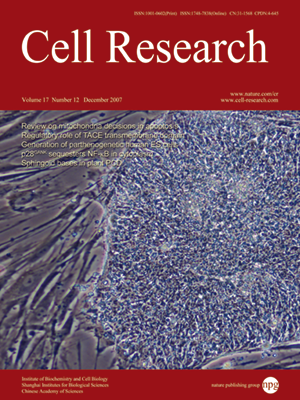Volume 17 Issue 12, December 2007: 1030-1040
ORIGINAL ARTICLES
Involvement of sphingoid bases in mediating reactive oxygen intermediate production and programmed cell death in Arabidopsis
Lihua Shi1,2,*, Jacek Bielawski3,*, Jinye Mu1,2,*, Haili Dong1,2, Chong Teng1,2, Jian Zhang1, Xiaohui Yang1, Nario Tomishige4, Kentaro Hanada4, Yusuf A Hannun3 and Jianru Zuo1
1National Key Laboratory of Plant Genomics, Institute of Genetics and Developmental Biology, Chinese Academy of Sciences, Datun Road, Beijing 100101, China
2Graduate School, Chinese Academy of Sciences, 19A Yuquan Road, Beijing 100049, China
3Department of Biochemistry and Molecular Biology, Medical University of South Carolina, 173 Ashley Avenue, Charleston, SC 29425, USA
4Department of Biochemistry and Cell Biology, National Institute of Infectious Diseases, 1-23-1, Toyama, Shinjuku-ku, Tokyo 162-8640, Japan
Correspondence: Jianru Zuo(jrzuo@genetics.ac.cn)
Sphingolipids have been suggested to act as second messengers for an array of cellular signaling activities in plant cells, including stress responses and programmed cell death (PCD). However, the mechanisms underpinning these processes are not well understood. Here, we report that an
Arabidopsis mutant,
fumonisin B1 resistant11-1 (
fbr11-1), which fails to generate reactive oxygen intermediates (ROIs), is incapable of initiating PCD when the mutant is challenged by fumonisin B
1 (FB
1), a specific inhibitor of ceramide synthase. Molecular analysis indicated that
FBR11 encodes a long-chain base1 (LCB1) subunit of serine palmitoyltransferase (SPT), which catalyzes the first rate-limiting step of
de novo sphingolipid synthesis. Mass spectrometric analysis of the sphingolipid concentrations revealed that whereas the
fbr11-1 mutation did not affect basal levels of sphingoid bases, the mutant showed attenuated formation of sphingoid bases in response to FB
1. By a direct feeding experiment, we show that the free sphingoid bases dihydrosphingosine, phytosphingosine and sphingosine efficiently induce ROI generation followed by cell death. Conversely, ROI generation and cell death induced by dihydrosphingosine were specifically blocked by its phosphorylated form dihydrosphingosine-1-phosphate in a dose-dependent manner, suggesting that the maintenance of homeostasis between a free sphingoid base and its phosphorylated derivative is critical to determining the cell fate. Because alterations of the sphingolipid level occur prior to the ROI production, we propose that the free sphingoid bases are involved in the control of PCD in
Arabidopsis, presumably through the regulation of the ROI level upon receiving different developmental or environmental cues.
Cell Research (2007) 17: 1030-1040. doi: 10.1038/cr.2007.100; published online 4 December 2007
FULL TEXT | PDF
Browse 1775


